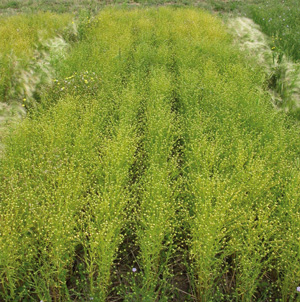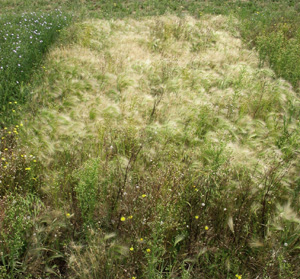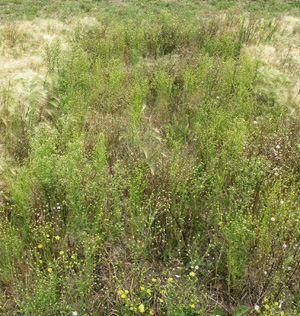
Features
Agronomy
Weeds
Flexible strategies for foxtail barley control
Control strategies vary according to spray timing.
March 5, 2008 By Bruce Barker
Foxtail barley is one prolific competitor producing several thousand seeds per plant. To go after it, a choice of herbicides and tillage can provide flexibility in dealing with varying environmental conditions from season to season. Targeted use of glyphosate plus selective in crop herbicides in oilseeds and pulses are the backbone of foxtail barley control programs.
 |
| With early seeding, a half litre of glyphosate pre-seed followed up with Assure II post-emergence gave good control. Photos Courtesy Of Ken Sapsford, University of Saskatchewan. |
“Established foxtail barley plants are best targeted in the fall when plants are naturally sending food reserves down to the root system,” says researcher, Bob Blackshaw at Agriculture and Agri-Food Canada at Lethbridge, Alberta. “But foxtail barley tends to mature before many crops, so the pre-harvest timing is not as consistently effective on foxtail barley as Canada thistle or quackgrass.”
Blackshaw has conducted several studies on foxtail barley in recent years. He says that foxtail barley becomes a more serious weed problem when tillage is reduced. And since reduced tillage and no-till are now the dominant seeding systems in western Canada, foxtail barley, which is easily controlled by tillage, is starting to spread beyond its normal saline soils locale.
For growers who do cultivate, shallow cultivation in the fall is usually more effective on large, established plants than spring cultivation. Blackshaw says that in direct seeding systems where foxtail barley has gone out of control, a shallow tillage can be a very cost effective control strategy. “Tillage can be used to reset the clock on foxtail barley plants, and then you can keep it in check with cultural and chemical control options,” says Blackshaw. “All of the soil quality benefits associated with zero-tillage will not be lost with shallow cultivation with an implement like the Noble Blade.”
Herbicide control difficult in some crops
Previously, Sundance and Anthem were registered herbicides in wheat, but with their withdrawal from the market, there are now no selective herbicides available for cereals. Because glyphosate is the backbone of direct seeding systems, Blackshaw has studied the best application timings for foxtail barley control.
If considering a pre-harvest glyphosate treatment, Blackshaw says the fields must be scouted to determine if the plants are growing and have green leaves before spraying. This timing can be effective if the plants are still growing and have not matured for the winter.
A more consistent timing can be September and October, but success depends on fall rains that promote foxtail barley growth. Blackshaw has found that glyphosate at one litre per acre applied pre-harvest or post-harvest can be expected to provide greater than 80 percent control of established plants if they are actively growing. “There is little benefit in going to higher rates of glyphosate. Actively growing plants are more important than increasing rates,” explains Blackshaw.
 |
| Heavy foxtail barley infestation in the untreated check. |
Glyphosate applied as a pre-seed burnoff at half to three-quarters of a litre per acre will control seedlings and suppress established plants. Blackshaw has found that increasing glyphosate rates at this time of year will not improve control of established plants.
Blackshaw has also conducted research on the effectiveness of post-emergence herbicides. In order of ranking, Assure II was the best followed by Poast Ultra, then Select, Fusion and Venture L. Blackshaw explains that these herbicides will control new seedlings in oilseed and pulse crops, but will only suppress the top growth of larger perennial plants. Of course, labels should be consulted to ensure that the herbicide is registered for use on the specific crops. “Foxtail barley is a relative of barley. If the herbicide hurts barley, then it will hurt foxtail barley as well,” explains Blackshaw.
Troy LaForge, a crop consultant with Green Key Solutions at Swift Current, Saskatchewan, can attest to the effectiveness of Assure II. “If growing an oilseed or pulse crop, Assure II has a high level of efficacy on foxtail barley, downy brome and Japanese brome.” LaForge cites a client’s field with a high population of foxtail barley. While the Assure II was used to target other grassy weeds (Assure II is not registered for foxtail barley control in any crop), it also did a very good job of controlling foxtail barley in the pulse crop with close to 90 percent control.
Still LaForge prefers to first manage foxtail barley in the fall when glyphosate has the best opportunity to control the perennial plants. He also says that control is a multi-year process because the seedbank can be quite high in affected areas.
Blackshaw says that glyphosate in Roundup Ready canola and Liberty/Select in Liberty Link canola systems would be expected to control seedlings also, but not established crops.
Getting started in the spring
Building on Blackshaw’s research, University of Saskatchewan research associate, Ken Sapsford looked into the best spring timing for foxtail barley control. “While fall is usually the best time for control, we wanted to find out if glyphosate wasn’t applied in the fall, is early or late spring application of glyphosate the best alternative,” explains Sapsford.
 |
| Assure II alone did not provide adequate control under early seeding conditions (without glyphosate pre-seed burndown). |
In 2005, a half litre per acre glyphosate pre-seed burndown was applied and then wheat was seeded a few days later. In 2006 and 2007, flax was grown. The pre-seed burndown was conducted either during the first week of May, or the last week of May. The crops were sown a few days later. In wheat, Sundance was applied post-emergence and in flax, Assure II was applied post-emergence.
Looking at the three years of data, Sapsford says that if seeding early with a half litre glyphosate pre-seed burndown, farmers would need to come back with Assure II in-crop in pulses or oilseed crops to clean up later germinating seedlings and to have some impact on larger plants. “We used the quackgrass rate of Assure II for the larger plants. I would like to see if we need to go that high for seedling control,” he says.
Conversely, with late seeding, Assure II did not improve foxtail barley control over the half litre glyphosate pre-seed application. With late seeding, farmers might get away with just a pre-seed burndown without the need for a post-emergence foxtail barley application. “The concern we have with delaying seeding for foxtail barley control is the effect on crop yield,” says Sapsford. “We saw reduced yields with wheat seeded late. The flax was variable. In 2007, we had higher flax yields with later seeding.”
To help farmers in other areas of the prairies equate the best timing, Sapsford says average growing degree days (GDD) can be used. For the pre-seed application at Saskatoon, Sapsford says the early application date was done at an average 120 GDD while the late application was at an average 250 GDD. He says farmers can go to www.farmzone.com to find their GDD accumulation during the spring to guide their spray decisions.
Given the variability in yields with late seeding, Sapsford says the best strategy for foxtail barley control, when fall applications were not successful, is to use an early pre-seed glyphosate application, followed by Assure II in pulse and oilseed crops. That is similar to Blackshaw’s recommendation, who also recommends a follow-up treatment with one to 1.25L/ac glyphosate post-harvest. “This approach should kill small seedlings before they become large clumps, which is very important, and will reduce the population of larger established plants over time,” explains Blackshaw.
A final component of foxtail barley control is to increase crop competitiveness. Blackshaw says his research has found that higher wheat and barley seeding rates will suppress foxtail barley plants and reduce seed production or future infestations. Also, subsurface banding of fertilizer reduces foxtail barley growth and competitiveness compared to surface broadcast fertilizer. -end-